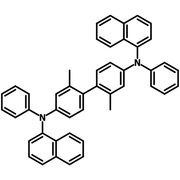α-NPD
CAS Number 495416-60-9
Charge Transport Layer Materials, High Purity Sublimed Materials, Hole Injection Layer Materials, Materials, OLED Materials, Semiconducting MoleculesA frequent electron rich 2,2′-dimethylbenzidine derivative
A hole transport and injection materials for OLEDs and OPVs
α-NPD (CAS number 495416-60-9), namely N,N′-Bis(naphthalen-1-yl)-N,N′-bis(phenyl)-2,2′-dimethylbenzidine, is a bis(triarylamine) that is joined by a 2,2'-dimethylbiphenyl unit. The only difference to NPB (N,N′-Bis(naphthalen-1-yl)-N,N′-bis(phenyl)benzidine) is that α-NPD has two extra methyl groups on the biphenyl bridging unit.
Bearing two triarylamine units, α-NPD is electron rich and known as a typical hole transporting material for organic electronics (OLEDs, OPVs). It is believed that the introduction of methyl groups in meta position on the central biphenyl unit of α-NPD is to create the distortion of the molecular geometry and consequently a decrease of the electronic conjugation as well as an increase of the band gap.
It is worth noting that α-NPD has also been identified as N,N′-bis(naphthalen-1-yl)-N,N′-bis(phenyl)benzidine in a lot of literatures. Please check the chemical structure, CAS (chemical abstract service) number and chemical name before you place the order with us.
General Information
| CAS Number | 495416-60-9 |
|---|---|
| Full Name | N,N'-Bis(naphthalen-1-yl)-N,N'-bis(phenyl)-2,2'-dimethylbenzidine |
| Synonyms | 2,2′-Dimethyl-N,N′-di-[(1-naphthyl)-N,N′-diphenyl]-1,1′-biphenyl-4,4′-diamine, α-NPD |
| Chemical Formula | C46H36N2 |
| Molecular Weight | 616.79 g/mol |
| HOMO/LUMO | HOMO = ~5.4 eV, LUMO = ~2.4 eV |
| Classification / Family | Triarylamine derivatives, Hole transport materials, Sublimed materials |
Product Details
| Purity | Sublimed >99.0% (HPLC) |
|---|---|
| Melting Point | >310 °C (0.5% weight loss) |
| Appearance | White to off-white powder/crystals |
Chemical Structure

Device Structures
| Device structure | ITO/HAT-CN (5 nm)/TAPC (30 nm)/mCP (15 nm)/1.0 wt% TXOPhCz4:o,o'-NPh2 (20 nm)/TmPyPB (50 nm)/LiF (0.9 nm)/Al (90 nm) [1] |
|---|---|
| Colour |
|
| Max. Current Efficiency | 30.2 cd/A |
| Max. EQE | 12.5% |
| Max. Power Efficiency | 27.1 lm W-1 |
MSDS Documentation
Literature and Reviews
-
Highly efficient white light-emitting diodes with a bi-component emitting layer based on blue and yellow thermally activated delayed fluorescence emitters, J. Mater. Chem. C, 6, 2951 (2018); DOI: 10.1039/c8tc00594j.
-
Resolving the Spatial Variation and Correlation of Hyperfine Spin Properties in Organic Light-Emitting Diodes, W. Pappas et al., Adv. Mater., 34 (11), 2104186 (2022); DOI: 10.1002/adma.202104186.
-
Nonradiative Recombination via Charge-Transfer-Exciton to Polaron Energy Transfer Limits Photocurrent in Organic Solar Cells, S. Khan et al., Adv. Energy, Mater., 12 (19), 2200551 (2022); DOI: 10.1002/aenm.202200551.

 α-NPD MSDS Sheet
α-NPD MSDS Sheet